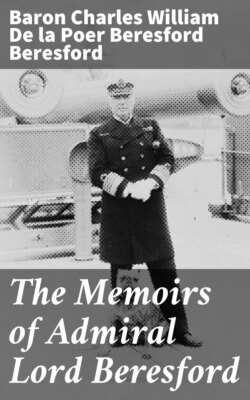Читать книгу The Memoirs of Admiral Lord Beresford - Baron Charles William De la Poer Beresford Beresford - Страница 5
На сайте Литреса книга снята с продажи.
CHAPTER I
I SEE THE FLEET
ОглавлениеTable of Contents
I saw the Navy for the first time in the year 1858, when I was twelve years old. The Channel Squadron came into the Downs; the admiral, who was a friend of my father, invited me to visit his flagship. The admiral put off from Deal in a six-oared galley, and I was taken into a second boat. Both crews began to pull with all their might. I remember being intensely excited, beating with my hand on the gunwale and urging the men to row faster. We were overhauling the admiral, when the boat in which I was slackened her pace.
"Row!" I shouted. "Why don't you go on rowing?"
"We can't pass the admiral, sir," said the coxswain. And that was my first lesson in naval etiquette.
As we drew near to the ships, there arose a great tumult of shouting, and I could see the men running to and fro and racing aloft, and presently they stood in rows along the yards, manning yards in honour of the arrival of the admiral.
The neatness and order of the stately ships, the taut rigging, the snowy sails, the ropes coiled down neatly on deck: these things left an abiding impression upon my youthful mind.
It was in the winter of the same year, 1858–9, that a certain young soldier, who had fought throughout the Indian Mutiny with great gallantry and conspicuous ability, came to his home in County Waterford on his first furlough. He was Lieutenant Roberts, V.C.; now Field-Marshal Earl Roberts of Kandahar.
"During the winter months," he writes, "I hunted with the Curraghmore hounds, and was out with them the day before Lord Waterford was killed. We had no run, and at the end of the day, when wishing us good-bye, he said 'I hope, gentlemen, we shall have better luck next time.' 'Next time' there was 'better luck' as regarded the hunting, but the worst of all possible luck for Lord Waterford's numerous friends; in returning home after a good run, and having killed two foxes, his horse stumbled over quite a small ditch, throwing his rider on his head; the spinal cord was snapped, and the fine sportsman breathed his last in a few moments." (Forty-one years in India. By Field-Marshal Lord Roberts of Kandahar. Bentley. 2 vols. London, 1897, p. 451, vol. 1.)
My father, the Rev. Lord John Beresford, succeeded to the marquisate. In the same year, 1859, I joined the Naval Service. I remember, some years afterwards, thinking with some degree of envy of my two younger brothers, each of whom had three hunters, while I was only the "blood-boat" (the jolly-boat bringing beef to the ship) midshipman of a man-of-war.
At that time the Navy consisted of both sailing ships and steamships. Steam was used as seldom as possible in those ships which were fitted with masts and yards. The flagships of the Cape of Good Hope, East Indies and China, South-east Coast of America, Pacific and North America and West Indies stations were all sailing ships. The Navy List of 1859 gives the names of no less than 548 "effective" ships, together with a list of 185 "steam gunboats" and a list of 121 vessels employed in Harbour Service.
That there was so large a number of "steam gunboats" was the result of the Crimean war, during which very many were built for service in the Baltic. There is a story that an admiral returning from foreign service noticed eight gunboats aground on the Spit. Upon his inquiry, he was informed by one of his crew that they were "commanded by these old Baltic War mates and second masters, the sort what knows nothing and fears nothing." But of the sailing master there will be more to say.
The line-of-battle sailing ships which were flagships on naval stations abroad were:—the Boscawen, 70 guns, Rear-Admiral Hon. Sir Frederick W. Grey, Cape of Good Hope; Calcutta, 84, Rear-Admiral Sir Michael Seymour, East Indies and China; Cumberland, 70, Rear-Admiral Sir Stephen Lushington, S.E. Coast of America; Ganges, 84, Rear-Admiral R. L. Baynes, Pacific; Hibernia, 104, Rear-Admiral H. J. Codrington, Malta; Indus, 78, Vice-Admiral Sir Houston Stewart, North America and West Indies.
The number of ships distributed among the various stations in 1859 was no less than 130. "Trade follows the flag."
